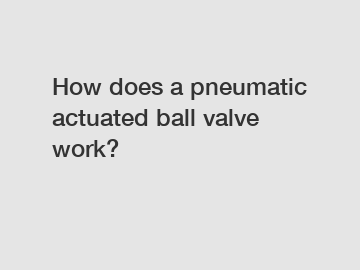How does a pneumatic actuated ball valve work?
How does a pneumatic actuated ball valve work?
A pneumatic actuated ball valve is a type of valve that uses compressed air or gas to initiate its movement. It consists of a ball-shaped disk with a hole in the middle that controls the flow of the fluid. When the actuator receives a signal from a control system, it activates the valve, allowing the ball to rotate, opening or closing the valve. This movement is achieved by the actuator pressurizing one side of the valve, causing it to rotate 90 degrees.
The working principle of a pneumatic actuated ball valve lies in the presence of the actuator. The actuator is equipped with a diaphragm or a piston that expands or contracts when air or gas is supplied. This movement is transmitted to a mechanism that rotates the ball within the valve body. The ball, being at a right angle to the flow when closed, obstructs the passage of the fluid, creating a shut-off. Conversely, when the ball rotates parallel to the flow, it allows the fluid to pass, enabling the valve to be opened.

The significance of the pneumatic actuated ball valve lies in its ability to provide quick, reliable, and precise control over fluid flow. The actuator, driven by compressed air or gas, allows for rapid response times, making it suitable for applications that require instant valve actuation. Additionally, the ball valve design offers a tight seal, preventing leakage even at high pressures. This feature ensures the valve's efficiency and durability in harsh environments or critical processes.
Furthermore, the pneumatic actuated ball valve offers flexibility in terms of control and automation. It can be easily integrated into control systems with the use of solenoids, limit switches, or positioners. This enables remote monitoring and control, making it ideal for applications that require centralized management. The valve's simplicity of design equates to ease of maintenance and reduced downtime, contributing to cost savings in the long run.
In conclusion, a pneumatic actuated ball valve operates by utilizing compressed air or gas to initiate the movement of a ball within the valve body. This movement controls the flow of fluid by either opening or closing the valve. The valve's working principle revolves around the actuator's ability to pressurize one side of the valve, causing it to rotate. This mechanism provides quick, reliable, and precise control over fluid flow, making it significant in various industries. Additionally, the valve's flexibility in control and automation, along with its simplicity of design, contributes to its widespread usage and impact across applications.
Are you interested in learning more about marine valve manufacturers, Marine Cast Bronze Valves company, China ball valve actuator pneumatic manufacturer? Contact us today to secure an expert consultation!
151
0
0


Comments
All Comments (0)